
Savarna
Savarna of New Zealand
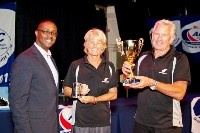
Who: Keith & Pam Goodall
Port: Auckland, New Zealand
18 July 2016
01 July 2016
30 May 2016
13 November 2015
27 October 2015
25 October 2015
22 October 2015
20 October 2015
17 October 2015
13 October 2015
10 October 2015
20 July 2015
23 May 2015
09 May 2015
09 May 2015
07 May 2015
07 May 2015
04 May 2015
30 April 2015
28 April 2015
Marquesas to Tahiti
20 July 2015
After leaving Savarna on anchor at Taiohae on Nuku-Hiva for five weeks we flew back in to be welcomed by Yannick who had rented a car to drive the 1.5 hours across the mountains to the airport in the north to meet us. On this passage we have been joined by friends Grant and Parry Stapleton.

Grant & Perry
Yannick had Savarna anchored in the western corner of the bay with a stern anchor out which given the bay is open to the prevailing wind was a good call until we came to retrieve the stern anchor. Ultimately we dropped off the anchor warp, picked up the bow anchor and then bow up to where we had buoyed the stern anchor and then used the primary winch in the cockpit and the spinnaker halyard to eventually break it out. It was great to return after five weeks to a very clean hull, polished cabin top and shiny stainless. We had a couple of days in Taiohae to visit the gendarmerie, provision up as best we could (fresh vegetables hard to find) and stock up the beer and wine store (expensive here but at least it is French wine!).
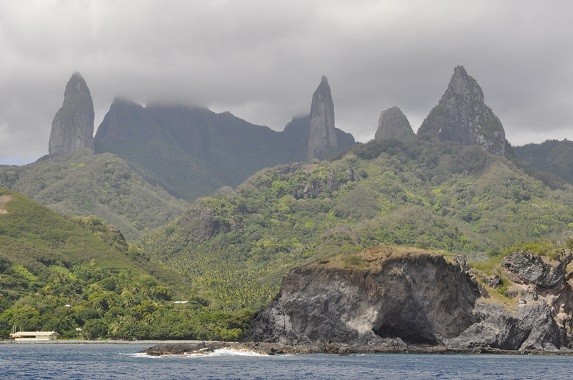
The basalt peaks on Ua-Pou
We departed Nuku-Hiva on 27th July for the 25 miles passage (a nice reach with the wind just ahead of the beam) to Ua-Pou where we thought we may find a calm anchorage on the western side of the island. We were successful in finding this in Baie De Vaiehu, to ourselves, under Cape Punahu having passed a couple of bays with several yachts at anchor.
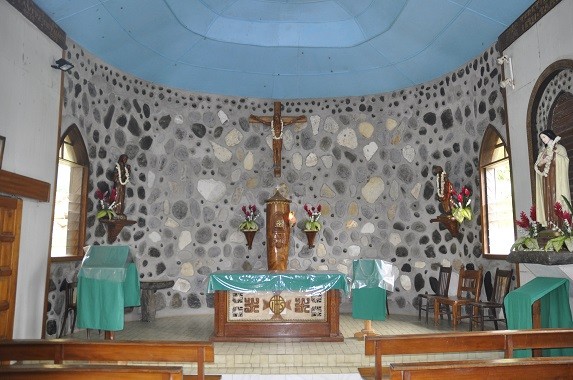
Church at Haakuti
The following day, Sunday 28th we motored to D'Haakuti which the pilot book described as a beautiful village where the locals sold fresh vegetables from their gardens. Alas while it was a beautiful village we could find no trace of vegetables for sale nor could we find a church service in the local church.
The next planned passage was to Fakarava Atoll in the Tuamotu's some 540 miles away. The deal with entry into an atoll is to not fight an outgoing current, more so if there is wind against current that can set up standing wave patterns, so we needed to plan our arrival so as to arrive at slack water and in daylight. So the plan was to leave Ua-Pou mid-afternoon so at least we would arrive in daylight at least and worry about the tide when we arrived.
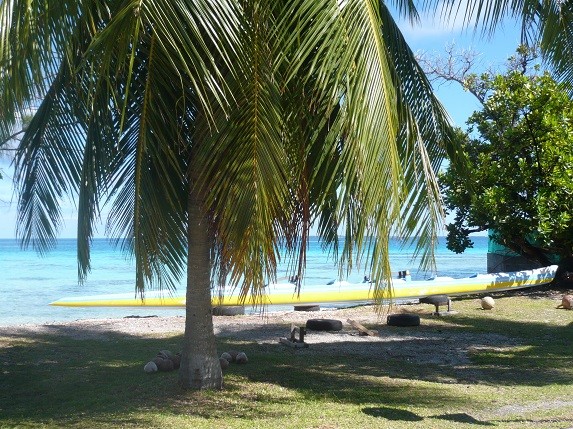
Rotoava village waterfront
The passage took us three days as expected, day one - great sailing with a tight reach in flat water, day two - seas heavier, good wind but still ahead of the beam, day three - lighter winds and calm seas. Managed to land a few tuna which turned into sashimi, steaks and curried fish.
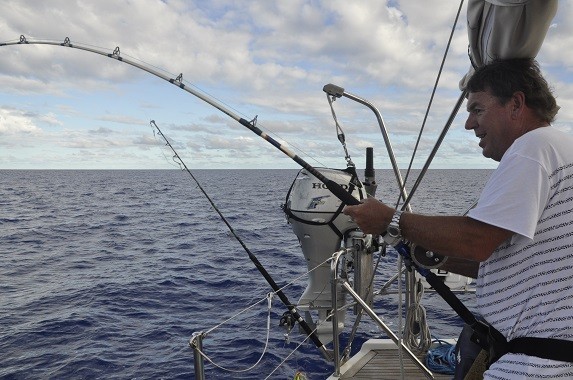
Grant on the rod
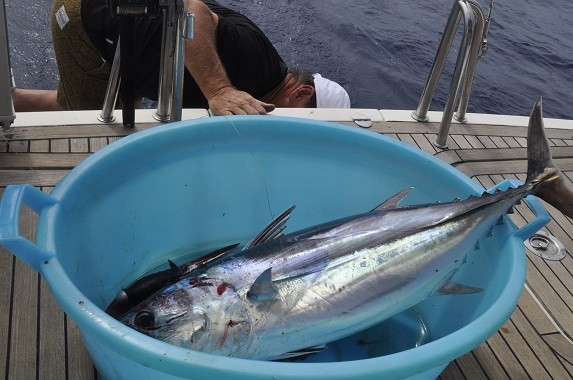
Look what he landed
The big event though was getting a 200 lb plus blue marlin on firstly the big rod and then after the line broke it arrived on the snapper rod. Grant put up a great fight and finally about 60 metres off the stern it did a spectacular tail dance that resulted on a broken line. Certainly Grant will have the best fishy tale "of the one that go away" for some years.
We motored through Passe Garuae pushing a 2.5 knot current with small waves but no problems. Motored for 5 miles along the inside of the reef dodging coral outbreaks and dropped anchor with several other yachts at the village of Rotoava. We found good friends Richard and Pippy on Matelot also at anchor and they joined us for dinner aboard - and a few beers of course as we caught up with their travels since leaving the Marquesas.
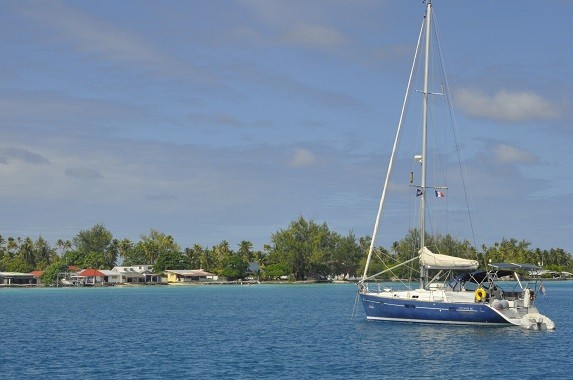
Matelot at anchor, Rotoava
The following day we went ashore and found a delightful village, incredibly clean (they were raking up leaves along the roadside) fresh baguettes and a boat building project underway to enable the locals to an monitor fish movement in the lagoon and to chart it properly. It looked like a great project and involved the building of an old styled craft in modern materials all sponsored by several major French corporates. These atolls are no more than 1.5 metres above sea level and little economic activity apart from pearl farming. Also with Richard and Pippy visited a local pearl farm owned by a German guy who had been on the atoll around 15 years. He gave us a good and interesting rundown of the pearl farming process.

Oyster intricacies at the pearl farm
The weather forecast was not looking too smart with very strong winds from the SE expected. Our response was to motor down to the south end of the lagoon where we figured we may get better protection anchored off Passe Tumakohua. There were around 18 yachts at anchor on the western side of the pass and we chose to anchor on the eastern side with a large catamaran nearby with the BBC film crew aboard.
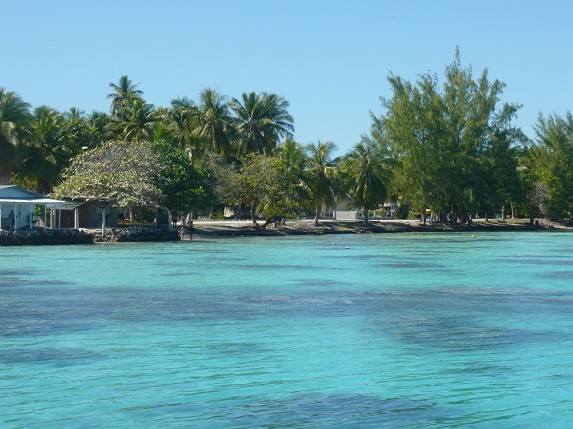
Atoll water colours
The following day it blew hard all day at around 40 knots and it was too rough to leave the boat - books, movies and dominoes produced a lazy day and no internet available! With the wind abating a little the following day we got ashore to explore around the pass and also by motoring in the dinghy out of the pass we could then drift back with snorkel and flippers at around 6 knots along the edge of the reef. Lots of black tip sharks, reef fish and some very large coloured fish that looked like reef fish on steroids. Once a year, at full moon, the groper return to the pass to spawn and the female rises off the bottom after releasing her eggs at which stage the sharks have a feeding frenzy. We were there a day or so after this event however the BBC, Vancouver TV and a French TV channel were all present with plenty of and expensive equipment. The water clarity was astoundingly clear and even sitting on the jetty it was like sitting in an underwater aquarium. The TV crews were saying it was the best in the world they had seen. Grant was sitting on the jetty when he felt a puppy licking his leg - on further investigation it turned out to be a pig! Life in the tropics!!
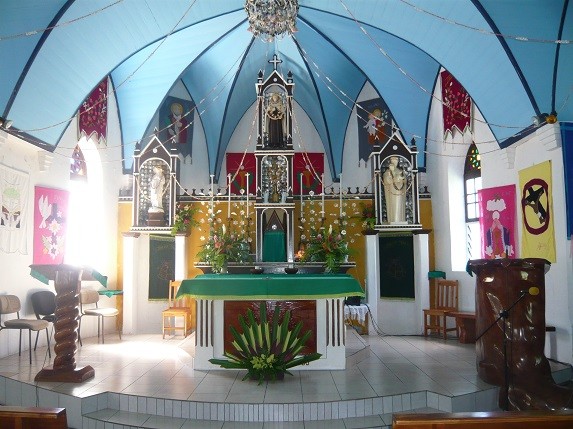
Church at Rotoava
The following day we sailed back up to the north end, anchored off Rotoava village (around 1,000 population) again and stocked up with fresh baguettes and got ready to depart for Papeete the following day. We motored through the pass and hoisted sail inn quite light winds just aft of the beam. About 50 miles into the 240 mile passage one of the motor alarms sounded and after hours of investigation determined that the fresh water pump bearings had disintegrated (because we found some in the bilge!!) so that put an end to any motoring.

Grant hooks another ?

The biggest tuna landed yet!
By this stage the wind was well down so it was sailing at 1.5 to 2.5 knots for most of the next 24 hours until a good bit of pressure arrived, big red made an appearance and we managed to make the reef entrance at Papeete early in the morning after 48 hours. But as the current was sweeping us past the entrance and the wind had completely died we called up the Port Authority and requested a tow in - they obliged quite promptly and took us what proved to be a very rough berth alongside but at the entrance to the new marina.
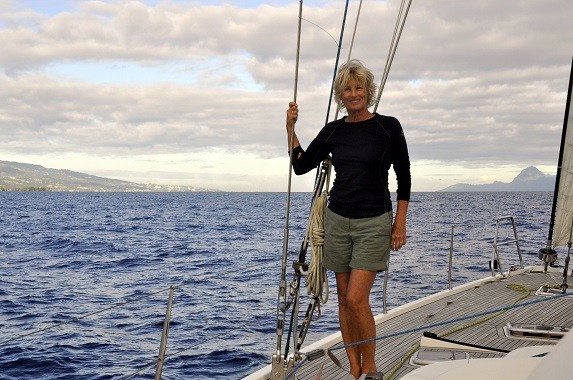
Approaching Papeete, Moorea to the left
The marina manager would not let us enter the dinghy without a motor so the next night after the marina office had closed we strapped the dinghy alongside and motored quietly into the best berth in the marina. The berthage system seems to be go help yourself to whatever berth takes your fancy.
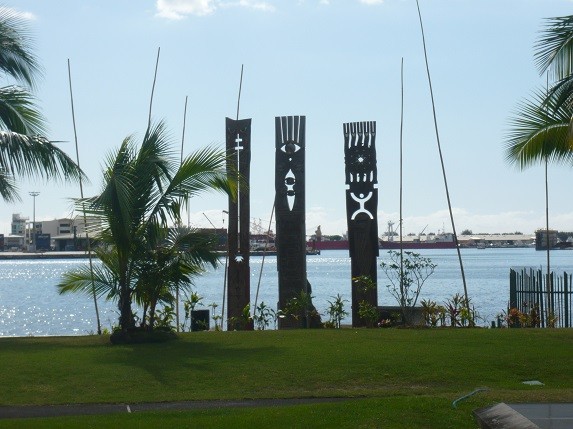
Mururoa monument near marina
is a brand new marina, in downtown Papeete, owned by the City where they only take cash (no credit cards on internet banking) and the manager has no marina experience but is a very friendly guy. In the meantime Matelot arrived, Sweet Chariot were already in the marina so a couple of very social nights before we flew out back to Auckland.
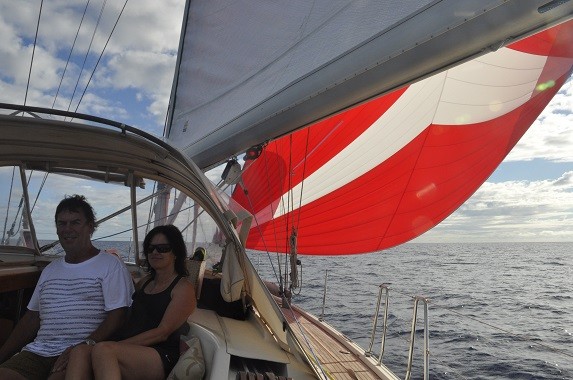
Cruising with big red!
The marine service industry seems to be more difficult than in the Caribbean. The one Chinese owned chandlery in Papeete have quoted 4-5 weeks to get in a new fresh water pump. I can get one on New Zealand in three days but if I have it shipped in the duty and tax is significant so the plan is to take the parts up in our luggage in mid-August when we go up again. Overall an easy passage with slight seas and nothing over 15 knots.
Cheers for now
Pam & Keith

Grant & Perry
Yannick had Savarna anchored in the western corner of the bay with a stern anchor out which given the bay is open to the prevailing wind was a good call until we came to retrieve the stern anchor. Ultimately we dropped off the anchor warp, picked up the bow anchor and then bow up to where we had buoyed the stern anchor and then used the primary winch in the cockpit and the spinnaker halyard to eventually break it out. It was great to return after five weeks to a very clean hull, polished cabin top and shiny stainless. We had a couple of days in Taiohae to visit the gendarmerie, provision up as best we could (fresh vegetables hard to find) and stock up the beer and wine store (expensive here but at least it is French wine!).

The basalt peaks on Ua-Pou
We departed Nuku-Hiva on 27th July for the 25 miles passage (a nice reach with the wind just ahead of the beam) to Ua-Pou where we thought we may find a calm anchorage on the western side of the island. We were successful in finding this in Baie De Vaiehu, to ourselves, under Cape Punahu having passed a couple of bays with several yachts at anchor.

Church at Haakuti
The following day, Sunday 28th we motored to D'Haakuti which the pilot book described as a beautiful village where the locals sold fresh vegetables from their gardens. Alas while it was a beautiful village we could find no trace of vegetables for sale nor could we find a church service in the local church.
The next planned passage was to Fakarava Atoll in the Tuamotu's some 540 miles away. The deal with entry into an atoll is to not fight an outgoing current, more so if there is wind against current that can set up standing wave patterns, so we needed to plan our arrival so as to arrive at slack water and in daylight. So the plan was to leave Ua-Pou mid-afternoon so at least we would arrive in daylight at least and worry about the tide when we arrived.

Rotoava village waterfront
The passage took us three days as expected, day one - great sailing with a tight reach in flat water, day two - seas heavier, good wind but still ahead of the beam, day three - lighter winds and calm seas. Managed to land a few tuna which turned into sashimi, steaks and curried fish.

Grant on the rod

Look what he landed
The big event though was getting a 200 lb plus blue marlin on firstly the big rod and then after the line broke it arrived on the snapper rod. Grant put up a great fight and finally about 60 metres off the stern it did a spectacular tail dance that resulted on a broken line. Certainly Grant will have the best fishy tale "of the one that go away" for some years.
We motored through Passe Garuae pushing a 2.5 knot current with small waves but no problems. Motored for 5 miles along the inside of the reef dodging coral outbreaks and dropped anchor with several other yachts at the village of Rotoava. We found good friends Richard and Pippy on Matelot also at anchor and they joined us for dinner aboard - and a few beers of course as we caught up with their travels since leaving the Marquesas.

Matelot at anchor, Rotoava
The following day we went ashore and found a delightful village, incredibly clean (they were raking up leaves along the roadside) fresh baguettes and a boat building project underway to enable the locals to an monitor fish movement in the lagoon and to chart it properly. It looked like a great project and involved the building of an old styled craft in modern materials all sponsored by several major French corporates. These atolls are no more than 1.5 metres above sea level and little economic activity apart from pearl farming. Also with Richard and Pippy visited a local pearl farm owned by a German guy who had been on the atoll around 15 years. He gave us a good and interesting rundown of the pearl farming process.

Oyster intricacies at the pearl farm
The weather forecast was not looking too smart with very strong winds from the SE expected. Our response was to motor down to the south end of the lagoon where we figured we may get better protection anchored off Passe Tumakohua. There were around 18 yachts at anchor on the western side of the pass and we chose to anchor on the eastern side with a large catamaran nearby with the BBC film crew aboard.

Atoll water colours
The following day it blew hard all day at around 40 knots and it was too rough to leave the boat - books, movies and dominoes produced a lazy day and no internet available! With the wind abating a little the following day we got ashore to explore around the pass and also by motoring in the dinghy out of the pass we could then drift back with snorkel and flippers at around 6 knots along the edge of the reef. Lots of black tip sharks, reef fish and some very large coloured fish that looked like reef fish on steroids. Once a year, at full moon, the groper return to the pass to spawn and the female rises off the bottom after releasing her eggs at which stage the sharks have a feeding frenzy. We were there a day or so after this event however the BBC, Vancouver TV and a French TV channel were all present with plenty of and expensive equipment. The water clarity was astoundingly clear and even sitting on the jetty it was like sitting in an underwater aquarium. The TV crews were saying it was the best in the world they had seen. Grant was sitting on the jetty when he felt a puppy licking his leg - on further investigation it turned out to be a pig! Life in the tropics!!

Church at Rotoava
The following day we sailed back up to the north end, anchored off Rotoava village (around 1,000 population) again and stocked up with fresh baguettes and got ready to depart for Papeete the following day. We motored through the pass and hoisted sail inn quite light winds just aft of the beam. About 50 miles into the 240 mile passage one of the motor alarms sounded and after hours of investigation determined that the fresh water pump bearings had disintegrated (because we found some in the bilge!!) so that put an end to any motoring.

Grant hooks another ?

The biggest tuna landed yet!
By this stage the wind was well down so it was sailing at 1.5 to 2.5 knots for most of the next 24 hours until a good bit of pressure arrived, big red made an appearance and we managed to make the reef entrance at Papeete early in the morning after 48 hours. But as the current was sweeping us past the entrance and the wind had completely died we called up the Port Authority and requested a tow in - they obliged quite promptly and took us what proved to be a very rough berth alongside but at the entrance to the new marina.

Approaching Papeete, Moorea to the left
The marina manager would not let us enter the dinghy without a motor so the next night after the marina office had closed we strapped the dinghy alongside and motored quietly into the best berth in the marina. The berthage system seems to be go help yourself to whatever berth takes your fancy.

Mururoa monument near marina
is a brand new marina, in downtown Papeete, owned by the City where they only take cash (no credit cards on internet banking) and the manager has no marina experience but is a very friendly guy. In the meantime Matelot arrived, Sweet Chariot were already in the marina so a couple of very social nights before we flew out back to Auckland.

Cruising with big red!
The marine service industry seems to be more difficult than in the Caribbean. The one Chinese owned chandlery in Papeete have quoted 4-5 weeks to get in a new fresh water pump. I can get one on New Zealand in three days but if I have it shipped in the duty and tax is significant so the plan is to take the parts up in our luggage in mid-August when we go up again. Overall an easy passage with slight seas and nothing over 15 knots.
Cheers for now
Pam & Keith
Comments
| Vessel Name: | Savarna |
| Vessel Make/Model: | Hanse 531 |
| Hailing Port: | Auckland, New Zealand |
| Crew: | Keith & Pam Goodall |
| About: | |
| Extra: | Earlier blog postings can be seen on www.yotblog.co.uk/savarna |
Gallery not available
Savarna of New Zealand

Who: Keith & Pam Goodall
Port: Auckland, New Zealand

